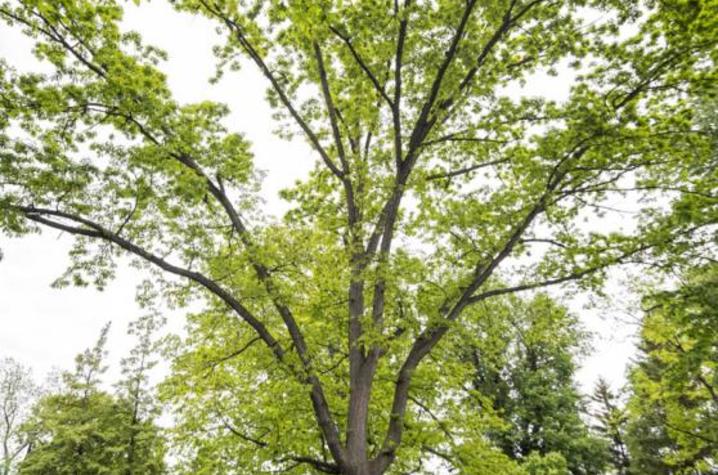Maxwell Place's White Oaks are Special in Many Ways

LEXINGTON, Ky., (May 25, 2016) — More than a mere spike of wood prodding the sky, a tree is a protector, a nurturer, a collector and a keeper of tales. Two white oaks in the yard at Maxwell Place on the University of Kentucky campus, trees that probably have witnessed much of UK’s history, embody all of that. And now they’ve been adopted, so others will know their story.
Rachel Landham, a graduate student in the Department of Forestry, and Anna Conrad, a postdoctoral scholar in Forest Health Research and Education Center, both in the UK College of Agriculture, Food and Environment, have spent time studying the oaks’ genetics — getting to know them, you might say — and decided it might be nice to adopt them through the Adopt-A-Tree program, part of the Urban Forest Initiative.
It is not unusual for people to form a personal connection with trees. "There is always something to make you wonder in the shape of a tree, the trembling of a leaf," Albert Schweitzer said. Henry David Thoreau wrote, “I frequently tramped eight or 10 miles through the deepest snow to keep an appointment with a beech tree, or a yellow birch, or an old acquaintance among the pines.”
Mary Arthur, UK forestry professor and co-leader of the initiative with Lynne Rieske-Kinney, UK forest entomology professor, said the idea behind the Adopt-a-Tree program was to promote the concept of noticing specific trees and thinking about what makes them special.
“We’re not the first people to ever adopt trees, but we wanted it to be about the relationship that people have with trees,” Arthur said. “When you ask people to think about trees, what you discover is people have these kinds of amazing personal stories and relationships with trees in general or a specific tree.”
Arthur said the idea was to link these personal connections to an understanding of all the ways trees give back, ways like sequestering carbon from the atmosphere, absorbing storm water runoff and providing protection from wind and heat.
Landham and Conrad are both interested in the genetic variability of white oaks. Landham’s research for her master’s degree focuses on white oak genetics and testing the DNA extraction protocol on white oak in the region — specifically in eight research plots near McKee, Kentucky, in the Daniel Boone National Forest and also on campus where possible.
“I remembered from my sophomore year when I took dendrology, which is learning how to identify trees, I learned specifically how to identify white oak from the two white oaks in the president’s yard,” Landham said.
She suggested to her advisers in the Forest Health Research and Education Center that she could take samples from the two iconic trees, thinking they could test the DNA extraction protocol, sequence the DNA and learn more about their ecological importance.
White oak is one of the dominant oaks found in Appalachia and throughout Kentucky. It provides a host of ecological services, including food for wildlife and habitat for birds and bats. On a human scale, they are an important component of the whiskey barrel industry.
“White oak is also commonly under the influence of forest management practices,” Landham said. “It’s been shown that forest thinnings increase the growth rate of these trees. My research is specifically looking at the impacts forest thinning has on genetic variability of that species within and among populations.”
Conrad said the Forest Health Research and Education Center recognizes the importance of white oak, both ecologically and economically. She is taking some of the DNA information Landham gathered from the Maxwell Place oaks to use in her study of white oak genetics.
“Ultimately, we hope that information obtained from these oaks can be used to support other efforts we have focused on white oak genetic improvement, so white oak will continue to be an important component of Kentucky forests,” Conrad said. “Our research could potentially help reforestation efforts and also assist in the wood-based products industry in the state.”
That is the big picture, but don’t discount the importance of the two oaks at Maxwell Place. To adopt the trees, the women submitted the measurement of their diameters at breast height or DBH. In the case of one tree, the DBH was 79.5 centimeters or 31.3 inches. The other was 96 centimeters or 37.8 inches. Once they had those measurements, they used the National Tree Benefits Calculator, a tool provided on the Adopt-a-Tree website, to calculate what the trees give back. In the case of the smaller tree, Conrad determined that the tree intercepts more than 9,000 gallons of storm water runoff each year, conserves 173 kilowatt hours annually and reduces atmospheric carbon by about 1,500 pounds, all of which results in a value of $135 annually.
The Adopt-A-Tree program is administered by Nic Williamson. For more information about adopting a tree, visit the Urban Forest Initiative website, http://UKnTrees.ca.uky.edu/adopt-a-tree. More information about the Forest Health Research and Education Center can be found at www.foresthealthcenter.org.
UK is the University for Kentucky. At UK, we are educating more students, treating more patients with complex illnesses and conducting more research and service than at any time in our 150-year history. To read more about the UK story and how you can support continued investment in your university and the Commonwealth, go to: uky.edu/uk4ky. #uk4ky #seeblue
MEDIA CONTACT: Carol Lea Spence, 859-257-8324




